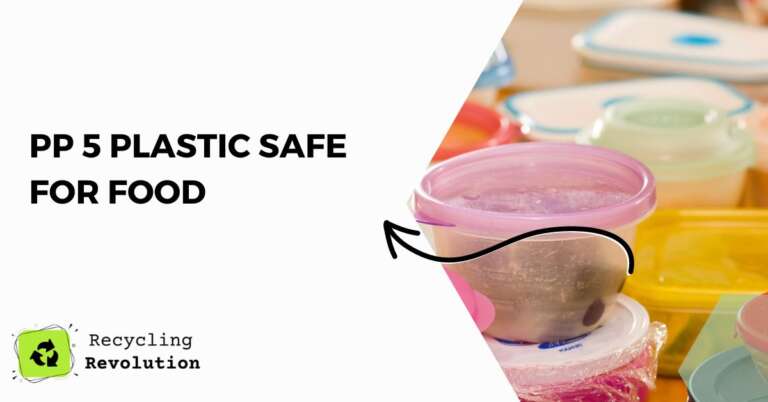When it comes to food safety, I recommend understanding the materials that come into contact with your food. One such material is PP 5 plastic, or Polypropylene.
It’s a robust and versatile type of plastic, widely used due to its resistance to heat, chemical erosion, and electrical conductivity.
TL;DR: Polypropylene, also known as PP or PP 5 plastic, is considered safe for food use. Its heat resistance, durability, and lack of harmful chemicals like BPA make it a common choice for food storage containers and other kitchen utensils. But it’s always wise to use it properly and ensure it is in good condition.
PP 5 plastic is commonly used in a variety of kitchenware and food storage products like microwave-safe containers, ketchup and syrup bottles, yogurt tubs, baby bottles, and reusable food containers. Its strength and heat resistance make it an ideal candidate for these applications.
🧴 Plastic Recycling Estimator
🔍 Plastic Buyback Facts
Most buyback programs accept PET (water bottles), HDPE (detergent containers), and PP (caps, cups). Light plastics like bags and wrappers are harder to recycle, but containers and jugs are highly valued. Recycling plastic reduces landfill overflow and saves fossil fuels.
Why PP 5 Plastic is Considered Safe for Food Use
There are several reasons why polypropylene is considered safe for food use:
- BPA-Free: PP 5 plastic does not contain Bisphenol A (BPA), a chemical found in some plastics that can leach into food and drinks, causing potential health hazards.
- Heat Resistant: PP 5 plastic has a high melting point, making it microwave safe. This means it won’t break down or release harmful chemicals when heated.
- Chemical Resistance: This type of plastic is resistant to chemical erosion, meaning it won’t leach chemicals into your food even when it comes into contact with acidic or fatty foods.
How to Use PP 5 Plastic Safely
Although PP 5 plastic is deemed safe for food use, it’s essential to use it correctly to maintain its safety:
- Check for Damage: Damaged or cracked containers might harbor bacteria or leach plastic into your food. I recommend replacing them immediately.
- Avoid Dishwashing: Although PP 5 plastic is heat resistant, it might not withstand the high temperatures of a dishwasher, leading to warping or damage. Hand washing is generally safer.
- Use Microwave-Safe Containers Only: While PP 5 is generally microwave-safe, make sure the container is labeled as such. Some containers have other parts (like lids) that aren’t microwave-safe.
Features and Applications
PP 5 plastic boasts a lightweight structure with a high resistance to cracking, making it durable and long-lasting. Its versatility extends beyond the kitchen, with applications in the automotive industry, textiles, consumer goods, and more. However, its strength and flexibility are particularly advantageous when it comes to food storage solutions.
Moreover, PP 5 plastic is resistant to moisture. In a kitchen environment, this resistance to moisture makes it an excellent choice for storing a range of food products, from dry pasta to juicy leftovers.
Furthermore, its resistance to heat allows it to safely undergo pasteurization and sterilization processes in the food packaging industry.
Is All PP 5 Plastic Created Equally?
It’s worth noting that while PP 5 plastic is generally considered safe, not all PP 5 plastic is created equal. The quality and safety of PP 5 plastic can be influenced by various factors, such as the manufacturing process, the presence of additives, and the intended use of the finished product.
Additives, for instance, are substances added to plastics to alter their properties or enhance their performance. While some additives are safe, others can potentially migrate from the plastic to the food, especially under certain conditions such as high temperature.
Thus, I recommend always purchasing food containers and kitchenware from reputable manufacturers who adhere to stringent safety standards. Look for products labeled as “food-safe,” which ensures they’re made to meet specific safety standards intended to keep your food safe from harmful substances.
Tips for Extending the Lifespan of PP 5 Plastic Items
To ensure the longevity and safety of your PP 5 plastic items, I suggest following these tips:
- Prevent Overheating: While PP 5 plastic is heat-resistant, it can still warp if exposed to excessively high temperatures. Avoid putting it in the oven or leaving it in hot cars.
- Avoid Harsh Cleaning Agents: Some harsh detergents and cleaning agents can degrade the plastic over time. Stick with gentle dish soap and warm water for cleaning.
- Avoid Rough Handling: While PP 5 plastic is sturdy, it can still break if dropped or hit hard. Handle with care to prevent cracks or breaks.
A Note on Environmental Impact
While discussing the safety of PP 5 plastic for food use, it’s also important to consider its environmental impact. Polypropylene, like other plastics, is derived from non-renewable fossil fuels and is not biodegradable.
While it is recyclable, the recycling rates for PP 5 plastic are relatively low. Hence, I recommend opting for reusable PP 5 plastic items over single-use ones wherever possible, and ensuring to recycle them properly at the end of their life.
Alternatives to PP 5 Plastic
If you’re looking for alternatives, consider the following options:
- Glass: This is an excellent alternative, as it’s reusable, recyclable, and does not leach any chemicals into food. Glass containers are also microwave and dishwasher safe.
- Stainless Steel: This is another safe option, especially for storing dry food. However, it’s not microwave-safe.
- Silicone: Food-grade silicone is heat-resistant, microwave-safe, and doesn’t contain harmful chemicals. However, it’s not as rigid as PP 5 plastic or glass, which might not be ideal for all storage needs.
Conclusion
In conclusion, PP 5 plastic is generally considered safe for food use, thanks to its durability, heat resistance, and lack of harmful chemicals. However, proper usage and maintenance are key to preserving its safety. And, if you’re seeking alternatives, glass, stainless steel, and silicone are all viable options.
FAQs
What is PP 5 plastic made of?
PP 5, or Polypropylene, is a type of thermoplastic polymer resin. It’s made from propylene monomers, hence the name Polypropylene.
How can I identify PP 5 plastic?
Look for a recycling symbol (a triangle of arrows) on the bottom of the container. Inside the symbol, you should see the number ‘5’ along with ‘PP’, indicating it’s made of Polypropylene.
Note: While PP 5 plastic is considered safe, always ensure that any plastic container you use for food storage or microwaving is specifically labeled as food-safe and microwave-safe.

